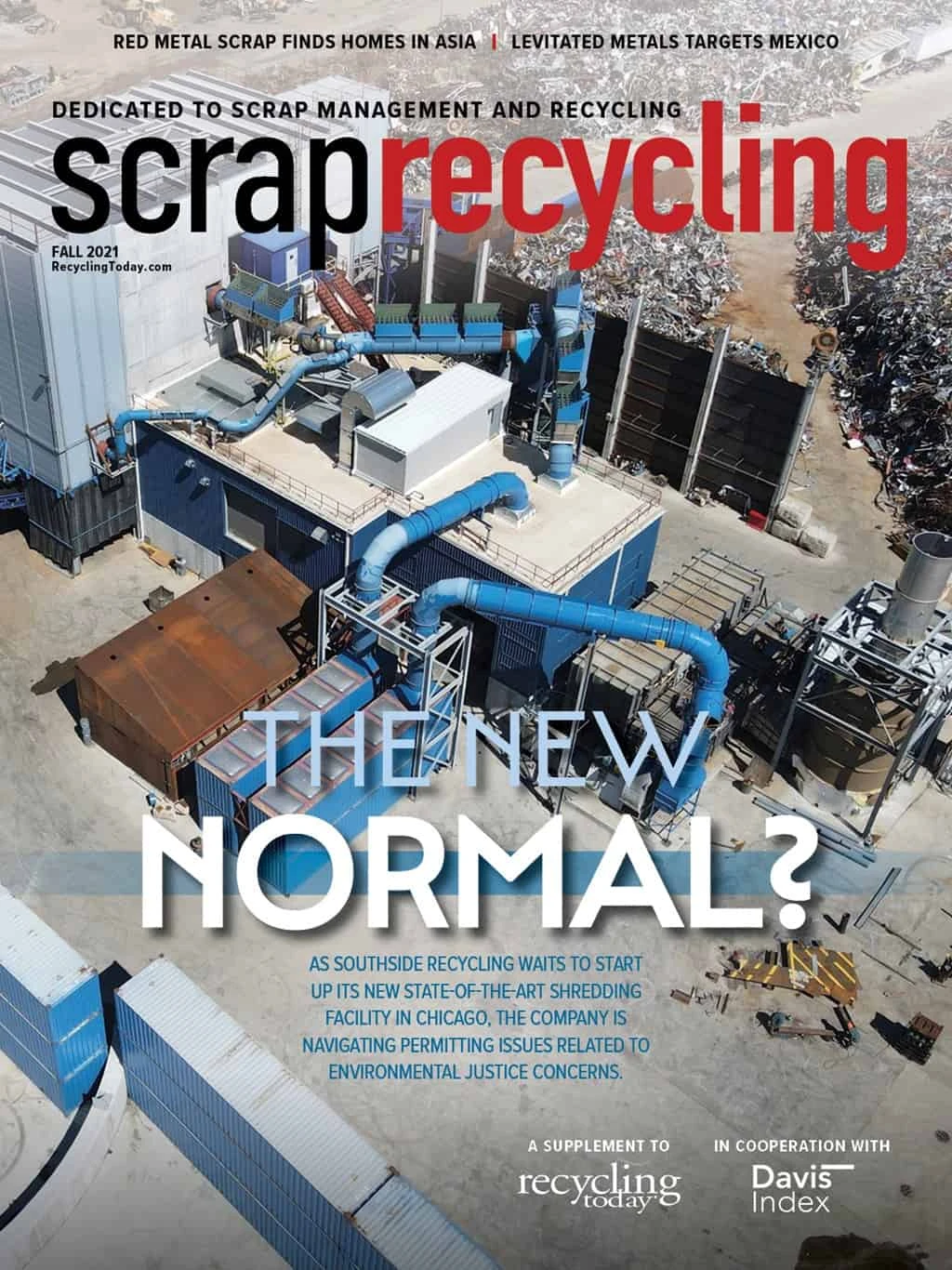
© erllre / stock.adobe.com

The growth of electric arc furnace- (EAF-) based steelmaking in the United States could affect scrap flows not only within the U.S. but also to Mexico, a key importer of ferrous scrap generated in the U.S. The resulting tightness and increased demand also could structurally raise prices for raw materials.
However, it is imperative to first understand how scrap flows today and where it is headed within the U.S.
A growing appetite
The U.S. is a net exporter of ferrous scrap, exporting around 20 percent while retaining the balance for domestic consumption. However, this ratio could change as growing capacity in the Southeast and South, and to a lesser extent in the Midwest, are destined to attract more ferrous scrap supplies regionally.
EAF expansions and restarts are planned in Alabama, Arizona, Arkansas, Colorado, Kentucky, Ohio and Texas. Expansions in Indiana and other states also are under consideration.
Moreover, a renewed focus on flat-rolled EAF steel production for the automotive, consumer appliances, oil and gas and specialty industries, which were traditionally satisfied by integrated steelmakers, will necessitate high-quality raw material inputs. Thus, market participants are evaluating the availability of U.S. ferrous scrap, especially prime grades.
Long-steel product capacity additions via rebar micromills also will add to ferrous scrap demand, but mill buyers report sufficient domestic volumes given the plentiful access to secondary grades, which make up more than 80 percent of the ferrous scrap produced in the U.S.
Impact on scrap generation
Some view scrap generation as finite, while others believe that volumes ultimately are influenced by pricing. In the latter perspective, higher scale prices will incentivize peddlers and nonindustrial operators to bring more volumes to yards for processing.
Philip Bell, president of the Steel Manufacturers Association, based in Washington, says U.S. steel mills are historically resilient and have given great thought to logistics in their new capacity investments.
“U.S. mills are well-positioned to address market fluctuations in supply chains, raw materials and price dynamics as they have been adapting continuously since their foundation,” Bell told Davis Index in an interview in the second half of 2020, adding that he anticipated a relatively balanced ferrous market.
Continued emphasis on recycling programs to divert ferrous and other metals from landfills along with improved recovery methods at scrap processing facilities will support growth of secondary ferrous scrap supplies. According to a U.S. Environmental Protection Agency report, landfills received 10.5 million tons of steel in 2018. However, prime grades, which rely on industrial production, are more finite, Phil Gibbs, equity research analyst at Cleveland-based KeyBanc Capital Markets, says.
If domestic metallics sources are insufficient, new mills actively will increase imports of prime grades and metallics as an EAF mix roughly consists of a 60/20/20 ratio of prime grades, metallics and obsolete grades, respectively, he says.
Mel Wright, president of Wright’s Scrap Metals in Texas, says scrap is currently limited at some yards and its supply is not just a factor of price. “Mills need to view scrap suppliers not just as a replaceable consumable source but a strategic resource partner, especially, given the upcoming tight market in the region.”
Mills also could do themselves a disservice if ferrous volumes and relationships are not well-planned, Wright says.
“Increased demand will require ferrous to be brought in from remote regions,” says Larry Stein, president of Tri Coastal Trading. Stein notes that the Southwest already is short on plate and structural and shredded ferrous scrap grades, which will require inbound shipments to satisfy growing demand.
Together, these factors will force mills to look beyond the U.S. for ferrous scrap, including to Canada, Mexico, Europe and other sources with high grades.
Integrated scrap supply
Steel Dynamics Inc.’s (SDI’s) mammoth 3-million-net-tons-per-year steel plant in Sinton, Texas, is anticipated to require 2 million gross tons of ferrous scrap, says Russell Rinn, executive vice president of SDI and chief operating officer of OmniSource, SDI’s fully owned scrap processing subsidiary. The Sinton plant also has an attached yard for processing scrap.
OmniSource will procure scrap via its internal sources and purchase processed scrap from regional dealers in addition to imports. OmniSource also is importing ferrous scrap, especially busheling, via its Mexico-based Zimmer S.A. de C.V. division, which it purchased in August 2020 in anticipation of SDI’s feedstock needs.
Zimmer has an annual processing capacity of 2 million metric tons but is estimated to have been shipping one-quarter of that volume at the time of its purchase, allowing bandwidth for substantial growth. OmniSource has the capacity to process 7 million metric tons of ferrous scrap annually and ships more than 5 million gross tons, according to its website.
SDI also will integrate scrap alternatives, such as direct reduced iron, hot briquetted iron (HBI) and pig iron, into its raw materials input mix. These ore-based products could account for up to one-third of the total raw materials mix, according to some reports. Their use reduces reliance on scrap, which not only provides demand relief but also addresses concerns about residual contamination in scrap arising from ongoing recycling.
Chad Ellerbrock, scrap procurement manager at Amsted Rail, Chicago, says steel producers continuously adjust the chemical composition in batches to address contamination while seeking to standardize output quality.
In addition to augmenting the capacity of its Osceola, Arkansas, mill from 1.7 million net tons to 3.3 million net tons by the end of 2021, Big River Steel (BRS), now part of Pittsburgh-based U.S. Steel’s growth strategy via EAF, continues planning for a 1.6-million-net-ton site in Brownsville, Texas. Once approved, that project would be four years out and require about 2 million to 2.2 million metric tons of ferrous scrap.
BRS Arkansas, through its procurement relationship with Koch Metallics, is obtaining scrap assets domestically and internationally by leveraging relationships for end-of-life asset management, demolition and alternative sources for scrap.
Cleveland-Cliffs, headquartered in Cleveland, recently announced its entry into ferrous scrap processing under Cleveland-Cliffs Services. Given the recent promotion of executive team members with expertise in mergers and acquisitions, financing and postintegration, the move points to upcoming ferrous scrap asset purchases in the domestic market.
Wright also mentions the possibility of other mills establishing or expanding their integrated supply chains through active acquisitions of scrap yards.

Dynamic but normalized Q4
Increased ferrous scrap demand in Texas is expected to reverberate all the way to the Mississippi River. The ferrous acquisition test OmniSource began this summer retreated in August given the delay in SDI Sinton’s launch, which is now anticipated for November, with buys to restart in October.
Scrap dealers throughout Texas, New Mexico and all the way east of Louisiana report contact with OmniSource buyers with intended purchases for October and November. The limited volume demand is not anticipated to shift dynamics in 2021, given the early ramp-up that will grow gradually over the next 12 months to reach full production capacity.
Market participants note that OmniSource did not get all the ferrous it sought for SDI and cast doubt on the claimed transportation problems. Some wonder whether tight availability of the needed grades also was a factor.
Exporters with frequent transactions to Mexico say they received more-than-enough offers of volumes in early September, pointing to oversupply, but lower proportions of the better grades.
In July 2021, ferrous trading encountered a slight uptick in prime grades, with sideways trading on secondary grades, such as shredded, structural steel and heavy melt, against June settled prices. August ferrous trading saw prime grades lose $10 per gross ton and secondary grades lose $20 to $30 per gross ton compared with July settled prices, depending on the region per supply overhang. September ferrous trading deepened the losses on secondary grades by $25 to $30 per gross ton while declining prices on prime grades at a deep $40 to $50 per gross ton discount against August settled prices. Ferrous declines followed the price corrections met by iron ore, too.
With an oversupply panorama for ferrous in September, which is likely to overflow into October, bottlenecks are not anticipated early in the fourth quarter of the year, but a moderate price increase is hoped for in November and December. Scrap generated from Hurricane Ida also could add to scrap feedstocks in October.
Scrap yards’ self-reported inflow statuses vary, with industrial and shredded flows remaining strong and not slowing down despite recent scale price declines, while others say they encountered a noticeable decline in peddler feedstocks from July to August.
These trends point to more headwinds in the next year for Mexican importers, who remain U.S. scrap’s largest consumers in the North American region.
Scrap flows to Mexico
U.S. ferrous scrap exports rose by 12 percent in the first half of the year to 8.8 million metric tons compared with the same period one year ago, according to U.S. Census Bureau data. While U.S. exports of ferrous scrap to Canada fell by 37 percent to nearly 526,000 metric tons in the first half of the year compared with the same period one year ago, they climbed by 68 percent to 1.4 million metric tons to Mexico in the same period.
With the bulk of the new steelmaking production capacity scheduled to come online next year, ferrous scrap availability could tighten in 2022, pushing prices up. Pricing for prime grades will increase, Gibbs says, which will buoy other grades.
The supply and demand dynamics on export are showing positive sentiment into 2022, but ambiguity given the COVID-19 variants over time is adding to market uncertainty. Exporters on the West Coast say that given the tight container market, high ocean freights and price stability in the U.S. domestic ferrous market, shipping to domestic mills in the South could become more attractive in some months.
West Coast exporters anticipate a surge in ferrous demand for bulk and container shipments as Asian markets balance from recent COVID-19 lockdowns. On the East Coast, despite the limited export environment, containerized shippers report a preference for selling the higher priced export loads as domestic prices in early September trended substantially lower. A strong 2022 export market will have U.S. mills competing with foreign demand.
In the meantime, Mexican mills, the second-largest destination for U.S. ferrous scrap, are knocking on doors in the U.S. Three bulk shipments were heard to be booked in late August for Mexican mills in the central region, one from Florida and two from the East Coast. West Coast exporters note the insatiable appetite from buyers south of the U.S. border.
Mexico is facing a dynamic production environment for finished steel goods at highly attractive prices in tandem with U.S. levels. Several Mexican ferrous importers say they believe mills are concerned about the net effect of higher scrap demand in 2022. Buyers are expanding supplier alternatives but acknowledge that an increase in ferrous scrap demand globally is likely to structurally increase prices.
Scrap alternatives
With the easing of demand for iron ore in China, its price has softened from recent historical highs. The situation, which is likely to be long term given the potentially higher iron ore volumes, China’s production caps and environmentally motivated restrictions, will make scrap alternatives attractive for new flat-rolled steelmakers.
Voestalpine’s plant in Texas and Cleveland-Cliffs’ Ohio plant will allow HBI to play a critical role in the supplies of scrap alternative raw materials.
Other North American developments to address the need for scrap alternatives are the new Stelco 1-million-metric-ton pig iron plant in Canada and the pending Petmin USA plant in Ashtabula, Ohio, which is projected to restart this fall.
WANT MORE?
Enter your email to receive our newsletters.

Explore the Fall 2021 Scrap Recycling Issue
Check out more from this issue and find your next story to read.
Latest from Recycling Today
- Republic Services, Blue Polymers open Indianapolis recycling complex
- Altilium produces EV battery cells using recycled materials
- Brightmark enters subsidiaries of Indiana recycling facility into Chapter 11
- Freepoint Eco-Systems receives $50M loan for plastics recycling facility
- PET thermoform recycling the focus of new NAPCOR white paper
- Steel Dynamics cites favorable conditions in Q1
- Hydro starts up construction in Spain
- Green Cubes unveils forklift battery line





